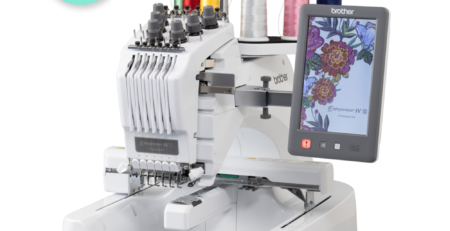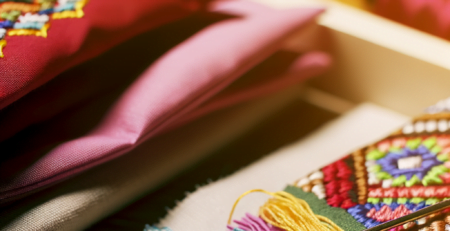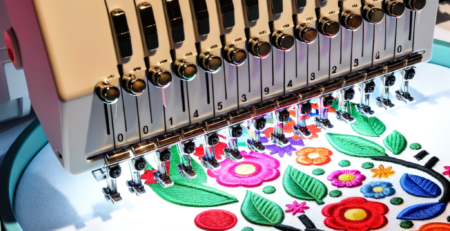Suggerimenti per ricamare asciugamani e altri tessuti spessi
Sommario
“Stitch with Success: Mastering the Art of Embroidery on Towels and Thick Fabrics”
introduzione
Embroidering towels and other thick fabrics can be a rewarding but challenging endeavor, as the plush nature and heavy weight of these materials require special techniques and considerations. To achieve a clean, professional-looking embroidery on such textiles, it is essential to understand the unique properties of thick fabrics and how they interact with embroidery threads and needles. Proper stabilization, needle choice, thread type, and design density all play crucial roles in the success of the project. By following a set of tailored tips and tricks, embroiderers can navigate the difficulties presented by these bulky materials and create beautiful, durable designs that enhance the luxurious feel of towels and add a personalized touch to thick fabric items.
Mastering the Art of Embroidery on Towels: Essential Tips and Techniques
Embroidering towels and other thick fabrics can be a rewarding endeavor, allowing for the creation of personalized and luxurious items that stand the test of time. However, the process requires a certain finesse and understanding of the unique challenges posed by heavier materials. To achieve professional-looking results, it is essential to consider several key factors, from the choice of materials to the finishing touches.
First and foremost, selecting the right needle is crucial when embroidering on towels and thick fabrics. A larger needle, such as a 75/11 or 90/14 embroidery needle, is typically recommended. These needles have a larger eye, which can accommodate heavier embroidery threads, and a sharp point that can penetrate thick fabrics more easily. Additionally, using a needle that is too small can lead to thread breaks and damage to the fabric.
The choice of stabilizer is equally important. A cut-away stabilizer is often the best option for heavy fabrics, as it remains attached to the fabric after the embroidery is complete, providing ongoing support for the stitches. For towels, a water-soluble topping can also be used in conjunction with the stabilizer. This topping prevents the stitches from sinking into the pile of the towel, ensuring that the design remains crisp and raised above the fabric’s surface.
Thread selection is another critical aspect of embroidering on thick fabrics. Polyester embroidery thread is a popular choice due to its strength and colorfastness, which is particularly important for items that will be frequently washed, such as towels. Cotton threads can also be used, but they may not withstand the wear and tear as well as polyester.
When it comes to hooping, care must be taken to avoid distorting the fabric. Hooping thick fabrics too tightly can stretch them out of shape, while hooping too loosely can lead to puckering around the design. A good practice is to hoop the stabilizer firmly and then float the towel on top, securing it in place with temporary adhesive spray or pins outside the embroidery area.
The design itself should be appropriate for the fabric’s weight and texture. Dense designs with high stitch counts can cause the fabric to bunch up or create a stiff patch that is uncomfortable against the skin. For towels, designs with open areas and lighter stitch densities often work best, allowing the fabric to maintain its natural drape and softness.
Once the embroidery is complete, finishing touches are essential for a professional look. Trimming jump stitches and any excess stabilizer is a must. If a water-soluble topping was used, it should be carefully removed according to the manufacturer’s instructions, typically by dabbing it with a damp cloth or sponge.
Finally, it is important to launder the embroidered item according to the care instructions for both the fabric and the thread. This will help to remove any remaining stabilizer and ensure that the embroidery settles into the fabric nicely.
In conclusion, embroidering on towels and other thick fabrics can be a delightful addition to any embroiderer’s repertoire. By carefully selecting the appropriate needle, stabilizer, and thread, and by adjusting the design and hooping technique to suit the fabric’s characteristics, one can master the art of embroidery on these challenging materials. With attention to detail and a bit of practice, the results can be both beautiful and durable, adding a touch of elegance to any home.
The Ultimate Guide to Embroidering Thick Fabrics: Overcoming Common Challenges
Embroidering towels and other thick fabrics can be a rewarding endeavor, allowing for the creation of personalized and luxurious items. However, it also presents unique challenges that can intimidate even experienced embroiderers. The key to success lies in understanding the specific requirements of these materials and adjusting your techniques accordingly.
One of the primary considerations when embroidering thick fabrics is the choice of needle. A larger needle, such as a 75/11 or 90/14 embroidery needle, is essential to penetrate the fabric effectively without causing damage. The larger eye of these needles also accommodates thicker threads, which are often necessary to ensure the embroidery stands out on the plush surface of a towel.
Thread selection is another critical factor. Cotton or polyester embroidery threads are commonly used, but one must consider the weight of the thread in relation to the fabric. A heavier weight thread, such as 30 or 40 weight, can provide the necessary coverage and prominence on a dense fabric. Additionally, the use of a water-soluble or heat-away topping can prevent the stitches from sinking into the pile of the towel, ensuring that the design remains visible and crisp.
Stabilization is paramount when working with thick fabrics. A sturdy cut-away or tear-away stabilizer will support the fabric during the embroidery process, preventing puckering and distortion. For towels, it is often recommended to use a cut-away stabilizer, as it remains with the fabric, providing ongoing support through multiple washes. The stabilizer should be larger than the hoop to ensure it is securely anchored during the embroidery process.
Hooping can be particularly challenging with thick fabrics. To avoid hoop burn, which is the crushing of the fabric’s pile, consider using a hoopless embroidery method where the stabilizer is hooped, and the fabric is then floated on top, secured with temporary adhesive spray or basting stitches. If hooping is necessary, ensure that the hoop is not too tight, as this can also damage the fabric.
Tension adjustments may be required to accommodate the thickness of the fabric and stabilizer. A looser upper thread tension can help prevent the bobbin thread from pulling to the top, while a tighter bobbin tension can prevent looping on the underside. It is advisable to test the tension settings on a scrap piece of the same fabric before beginning the actual project.
The design itself should be suitable for thick fabrics. Designs with open areas and less dense stitching work better on towels, as they allow the fabric’s texture to complement the embroidery. Dense designs with heavy stitch counts can lead to a stiff and uncomfortable result. Reducing the density of a design can be done using specialized software, or by choosing designs that are specifically created for use on thick fabrics.
Finally, patience and practice are essential. Embroidering on thick fabrics like towels may require slower machine speeds and more frequent thread changes. Taking the time to test and adjust settings for each new project will lead to better outcomes and a more enjoyable embroidery experience.
In conclusion, while embroidering towels and other thick fabrics can be challenging, these obstacles can be overcome with the right tools and techniques. By selecting appropriate needles and threads, stabilizing effectively, adjusting hooping and tension, and choosing suitable designs, embroiderers can achieve professional and beautiful results on even the most luxurious of thick fabrics.
Innovative Embroidery Hacks for Towels and Dense Materials: A Step-by-Step Approach
Embroidering towels and other thick fabrics can be a rewarding endeavor, allowing for the creation of personalized and luxurious items. However, it requires a nuanced approach to ensure the final product is both aesthetically pleasing and durable. This article will provide a step-by-step approach to mastering the art of embroidering on towels and dense materials, offering innovative hacks to overcome common challenges.
The first step in embroidering thick fabrics is selecting the right materials. When choosing a towel, opt for one with a tight weave and high-quality fibers, as this will provide a stable foundation for your embroidery. Similarly, the choice of thread is crucial; a thicker, stronger thread such as polyester or rayon is recommended for its durability and sheen, which can withstand the towel’s texture and frequent washing.
Before beginning your project, it is essential to prepare the fabric properly. Prewashing the towel can prevent future shrinkage and distortion of the embroidery. After washing and thoroughly drying the towel, iron it to remove any wrinkles or folds that could interfere with the embroidery process.
Stabilization is key when working with thick fabrics. A cut-away or tear-away stabilizer should be applied to the back of the area to be embroidered to prevent puckering and maintain the design’s integrity. For towels, using a water-soluble topping on the fabric’s surface can also help the stitches stand out against the pile and prevent them from sinking into the fabric.
Choosing the correct needle is another critical factor. A larger needle, such as a size 75/11 or 90/14 embroidery needle, is ideal for penetrating thick fabrics without causing damage. The needle’s eye should be large enough to accommodate the thread while minimizing friction, which can lead to thread breakage.
When setting up your embroidery machine, it is advisable to reduce the speed. This allows for more precise stitching and reduces the risk of needle breakage or skipped stitches. Additionally, adjusting the tension settings may be necessary to accommodate the thickness of the towel and the stabilizer.
The design itself should be considered when embroidering on thick fabrics. Designs with open areas and less dense stitching tend to work better on towels, as they allow the fabric’s texture to complement the embroidery rather than compete with it. Avoid designs with small details or very dense stitching, as these can become lost in the fabric’s pile or cause the towel to become stiff and uncomfortable.
Once the embroidery is complete, it is important to finish the project properly. Gently remove any excess stabilizer, being careful not to distort the stitches. If a water-soluble topping was used, it can be removed by lightly dabbing it with a damp cloth or sponge. Finally, press the embroidered area from the backside to give it a professional finish.
In conclusion, embroidering towels and other thick fabrics can be a delightful addition to any textile project. By carefully selecting materials, preparing the fabric, stabilizing appropriately, choosing the right needle, adjusting machine settings, selecting suitable designs, and finishing with care, even the most luxurious towels can be transformed into bespoke items. With these innovative embroidery hacks, you can confidently tackle any project involving towels and dense materials, creating beautiful, high-quality results that stand the test of time.
Conclusione
Conclusione:
When embroidering towels and other thick fabrics, it is essential to use the right techniques and materials to achieve the best results. Key tips include choosing the appropriate stabilizer, such as a cut-away or tear-away type, to provide adequate support for the fabric. Using a water-soluble topping can help keep stitches from sinking into the fabric’s pile. Selecting the correct needle, like a larger-sized embroidery or sharp needle, will ensure smooth penetration through the thick fabric without causing damage. Adjusting the machine tension and reducing the embroidery speed can help prevent thread breakage and ensure even stitching. It’s also important to consider the design density and use proper hooping techniques to maintain fabric stability during the embroidery process. By following these tips, embroiderers can produce high-quality, professional-looking designs on towels and other thick fabrics.





Lascia un commento